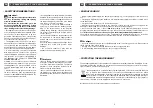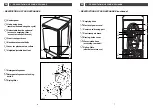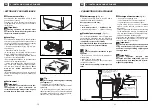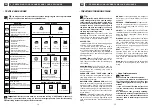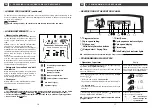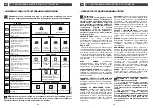
15
EN
14
EN
3 / PREPARING YOUR LAUNDRY AND YOUR APPLIANCE
3 / PREPARING YOUR LAUNDRY AND YOUR APPLIANCE
Fig. 15
A
A
Fig. 14
•Laundry loads
Important :
For optimum results, do not overload the drum and do not exceed the follo-
wing maximum loads :
Cotton/Colors
____________________
6 kg
Mixed
____________________________
3 kg
Delicates/Wool
____________________
2 kg
•Checking your laundry
Important :
Failure to follow these recommendations can cause serious or even irrever-
sible damage (damaged drum, torn laundry, etc.) and will void the warranty.
— Empty pockets: remove all objects such as lighters and matches, etc.
— Close zippers and press fasteners.
— Remove hooks from net curtains or place your net curtains in a washing bag.
— Remove poorly-attached buttons, pins, clips.
— Place small items of laundry (ribbons, pouches, etc.) in a washing bag.
— Turn multi-layer garments inside out (sleeping bag, anorak, etc.).
— Turn knits, fabrics with embossed decoration, trousers and stitched garments inside out.
• PREPARING YOUR LAUNDRY
•
•
Sorting your laundry :
Refer to the textile care codes table for sorting
your laundry and choose the program that best
suits the labels. For mixed loads, use the pro-
gram suited to the most delicate laundry. For
new laundry, take the precaution of checking
that the fabric does not bleed: see
"Colour
test"
opposite.
•The colour test :
At the first wash, coloured laundry often
bleeds, except if it is guaranteed colourfast.
Before placing it in the machine, perform the
following test:
— Take an inconspicuous part of the item
— Dampen it using hot water
— Then press it against a white cloth
— If the colour does not bleed, you can wash it
normally in the machine.
— If the colour does bleed, wash it separately
in the machine or by hand.
Cotton t-shirt, large size
____________
150 g
Dish towel
________________________
100 g
Tablecloth
________________________
250 g
Delicate lingerie
____________________
50 g
Child's synthetic woollen items
________
50 g
Sock
______________________________
20 g
Adult's plain weave pyjamas
__________
250 g
Average weight of some items of "light" dry laundry
Single sheet
________________
400 to 500 g
Double sheet
______________________
800 g
Pillowcase
________________________
200 g
Light night shirt
____________________
150 g
Child's plain weave trousers
________
120 g
Adult's plain weave trousers
________
500 g
Cotton/polyester men's shirt
________
200 g
Average weight of some items of "heavy" dry laundry
Adult's jeans
________________
800g to 1 kg
Large bath towel
__________________
700 g
Small towel
______________________
300 g
Adult's sweat pants
________________
350 g
Child's terry pyjamas
________________
100 g
Bathrobe
________________________
1200 g
Sweat shirt
________________________
250 g
Quilt cover
______________________
1500 g
• PREPARING YOUR LAUNDRY (continued)
The fibres in your laundry are of varying types
and origins; their reaction to drying is there-
fore very variable
Generally speaking, all machine-washable
fabrics may be dried in a tumble dryer except
for :
— wool, silk, netting and nylon tights or
stockings
— plasticised fabrics
— chlorofibres (Thermolactyl* for example)
— laundry items with plastic foam, rubber or
reinforcements that would be likely to become
detached
* : Registered trademark
— bulky items (quilts, eiderdowns, etc.)
— unwashed or unspun laundry
— laundry that has been cleaned using chemi-
cals
Important :
Avoid drying light textiles and heavy
cotton textiles together as the weight of the
heavy fabrics crushes the lighter ones.
Important :
It is preferable to dry non-colourfast
fabrics separately.
•Checking your laundry before drying
Substances contained in soiling such as cooking oil, acetone, alcohol, petrol, kerosene, stain remo-
vers, turpentine or wax must be removed before drying in your machine (by using an adapted warm
water washing program with additional detergent for example).
• LOADING YOUR LAUNDRY
Conduct operations in the following order:
•Opening the machine
— Check that the machine is switched off.
— Press the knob located at the front of the
machine. The lid opens.
•Opening/Closing the drum
— Open the drum by pushing on the knob loca-
ted on the front door
(Fig. 14).
— To close them again, push the front door
downwards then close the rear door on top,
until it locks.
Important :
For correct locking, check that the blue
edging
of the knob is visible (Fig. 15).
A
A
Содержание WTD 63111
Страница 1: ...EN Instructions for Use RU Washer Dryer...
Страница 34: ...67 Z Y RU 66 Z Y RU...
Страница 35: ...WTD 63111 WTD 63131 TW2G00259_01 1 3 01 12...



